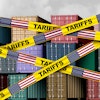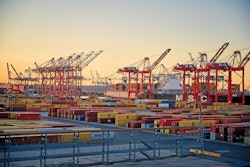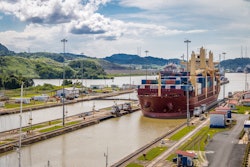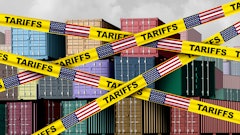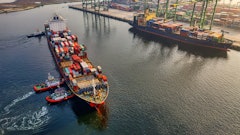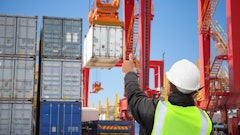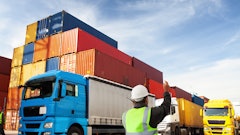
When it comes to U.S. ports and ocean carriers, it’s safe to say that for a sector traditionally stagnant, it’s experienced a great deal of change over the past couple of years.
From dockworker strikes and heightened adoption of nearshoring to an uptick in fuel charges, a deteriorated infrastructure and economic uncertainty with regards to increased tariffs, the ripple effect has been – and will continue to be -- felt across all ports nationwide.
But what does this all mean for 2025? And what will the State of Ports and Ocean Carriers look like in the New Year?
Food Logistics talks exclusively with Christian Roeloffs, CEO, Container xChange, about the State of Ports, what President Trump’s re-election means for the future and more.
CLICK HERE to read the full article.
Food Logistics: The global container shipping industry continues to witness an increase in freight demand for U.S.-bound shipments. What does this mean? And what will this look like come 2025?
Christian Roeloffs: North America has experienced the sharpest rise of 20% in average container prices over the last 90 days, driven by market volatility, U.S. elections uncertainty (and tariff woes), surge in Mexico-US trade, and logistical disruptions in Canada.
Interestingly, the North America region recorded the largest increase in average container prices, with 40-foot HC cargo-worthy container prices rising by 20% over the past 90 days. This reflects that North America has been the most volatile market for container trading prices for 40-foot-high cube containers, followed by East Africa and Southeast Asia in the last 90 days.
Average prices for 40-foot-high cube containers in Boston jumped by 17% from $1855 in October to $2170 in November. These prices increased by 5.6% in Chicago, 5.8% in Houston and New York from October to November.
The potential implementation of new tariffs under the Trump administration, including universal tariffs of up to 20% and higher rates on Chinese imports, could provoke retaliatory measures from key trade partners.
These responses are expected to strain U.S. exports by increasing costs, reducing competitiveness, and further destabilizing global trade dynamics. This is expected to have a significant impact on the container shipping sector.
Tariffs make trade less efficient by adding costs, time, and complexity. For instance, instead of straightforward routes, businesses may rely on transshipments, rerouting through Mexico, or diversifying production and assembly sites. This inefficiency requires additional capacity, much like what we saw during Red Sea diversions. Consequently, we anticipate container prices and freight rates to stay elevated, supporting demand for containers and vessel capacity. However, retaliatory tariffs and inflationary pressures will likely harm U.S. exports more than imports, creating broader imbalances in trade dynamics.
Higher tariffs will further accelerate the ongoing process of trade risk diversification, which began during the COVID-19 pandemic when economies recognized the need to reduce dependency on single trade partners and build resilience against future disruptions. While this could create opportunities for new trade routes, it may also lead to a temporary mismatch in container supply and demand.
Food Logistics: From your vantage point, what are some of the top disruptions impacting ports and ocean carriers? And, why?
Roeloffs: The top disruptions impacting ports and ocean carriers include:
· Geopolitical Tensions: Continued trade wars, particularly between the U.S. and China, and conflicts in the Red Sea region.
· Climate Change: Issues like the Panama Canal drought are delaying shipments and raising costs for ocean carriers.
· Labor Tensions: Strikes or labor contract renegotiations add uncertainty to port operations, particularly in the U.S. East Coast.
· Technological Regulations: Stricter environmental policies, such as IMO 2023, require carriers to invest heavily in greener solutions, impacting costs.
Food Logistics: What does Donald Trump’s re-election mean for the future of ports and ocean carriers., i.e., tariffs?
Roeloffs: A Trump re-election would likely reignite tariff policies, leading to higher costs for importers and ocean carriers. The emphasis on "America First" could mean stricter trade regulations and a reallocation of supply chains away from traditional U.S.-China routes. Nearshoring strategies, particularly involving Mexico, would gain further momentum as businesses seek to mitigate tariff risks.
Food Logistics: The International Longshoremen’s Association (ILA) and the United States Maritime Alliance (USMX) reached a tentative agreement on wages, extending the Master Contract until Jan. 15, 2025. What does another possible port strike mean for U.S. supply chains?
Roeloffs: The looming January 15 deadline for negotiations between the International Longshoremen’s Association (ILA) and the U.S. Maritime Alliance (USMX) has raised significant concerns about potential disruptions to U.S. supply chains. If a strike occurs, it could impact operations at 36 major East and Gulf Coast ports, which handle a substantial portion of U.S. imports and exports. Key implications include:
· Disruption Across Industries: Retail, manufacturing, automotive, agriculture, and energy sectors are particularly vulnerable. Delays in imports of consumer goods, raw materials, and critical components could affect inventory levels, production timelines, and consumer access to products.
· Increased Freight Costs: Businesses may need to rely on costlier alternatives like air freight or rerouting shipments to less-congested ports, straining budgets and logistics networks.
· Inventory Management Challenges: Retailers have already begun stockpiling goods to mitigate potential disruptions. U.S. import volumes have surged, with October and November seeing year-over-year increases of 9% and 15%, respectively.
· Strain on Domestic Logistics: A strike could lead to congestion in domestic trucking and rail systems as businesses adapt their supply chains.
· Automation Disputes at the Core: Negotiations are stuck on issues like wage increases and the adoption of semi-automated port equipment. A breakdown in talks could lead to delays in post-holiday restocking and heightened supply chain uncertainty
Food Logistics: Nearshoring is becoming a more common approach to supply chain optimization. What are some of the pros/cons of nearshoring? What does this mean for the state of imports and exports?
Roeloffs: Pros:
- Reduced lead times and transportation costs.
- Improved resilience to disruptions like tariffs or shipping delays.
- Greater supply chain control and visibility.
Cons:
- Higher production costs compared to offshore manufacturing.
- Potential capacity challenges in nearby regions, such as Mexico.
Nearshoring will reduce U.S. dependency on distant Asian markets, particularly China, and accelerate trade flows between the U.S. and neighboring regions like Latin America.
CLICK HERE to read the full article.




